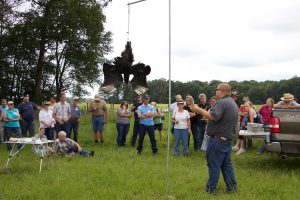
WOOSTER, Ohio — Predator concerns are rising for sheep producers all over the state. Along with coyotes, producers from across Ohio are experiencing black vulture attacks.
“Black vultures are southern birds,” said Tommy Butler, a certified wildlife biologist with USDA Wildlife Services who spoke July 15 during the Ohio Sheep Day in Wooster.
However, in the last 10 to 15 years, the birds have been moving north, he explained. Producers from Summit, Wayne, Ashland and Lorain counties noted they have spotted the vultures near their flocks.
Unlike turkey vultures that feast on the carcasses of dead animals, black vultures are very aggressive — attacking live animals, especially during birth. Butler explained the Migratory Bird Treaty Act protects vultures, but there are things producers can do to protect their flocks.

Take action
Black vultures like mature forests where they can roost and look over open fields, explained Butler. Once producers start seeing vultures on their property, they need to take action. “Don’t let them get comfortable,” said Butler.
While it is illegal to shoot the birds without a permit, it’s not illegal to harass them. Make loud noises, shoot pyrotechnics or guns near them to try and scare them off.
If that’s not working, Butler suggests applying for a permit, which will allow producers to shoot up to five birds in a year.
Black vultures are social birds, Butler said. Once you have your permit, he suggests shooting one from inside a group of birds, so the other birds witness it. Then continue to make noises and harass the remaining birds until they leave.
You can then use the dead vulture as effigy to hang near where the birds continue to roost. Butler also suggests cutting down any dead trees in the pasture where the vultures like to roost.
Tips
Butler also offers other basic tips for protecting livestock from predators.
“Have good fencing,” he said. The small wire squares in the fencing used by the OARDC are good for keeping predators like coyotes out. It’s also important to keep the fencing flush with the ground. “If something is digging it’s way under, you can see right away where it is getting in,” he said.
Keep pastures clean by clipping vegetation along fence lines. Tall grass along fence rows provide good cover for wild animals. It’s also important to keep brush piles and old abandoned equipment out of fields. These also provide cover to predators.
“Spend time with your livestock,” said Butler. The more time you spend out in your fields or near your animals, the less likely predators will linger.









